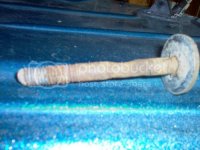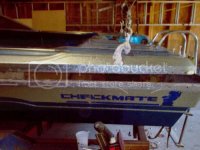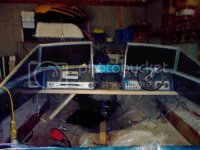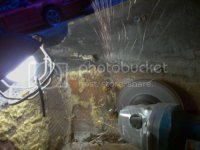groundloop
Active member
Bought this '79 Eluder (which was listed for sale here) a few weeks ago and was finally able to tear into it this past weekend. The seller said the only thing wrong with her was a soft spot in the deck, up in the bow. Well, I had a pretty good idea that there was more to the story than that, and when I inspected her my suspicions were confirmed. The foam under the deck was so soggy that water was standing in the in-floor drink holders, the battery box was mush, and there was standing water under the deck in the bow. I went ahead with the purchase anyway because cosmetically she's in pretty good shape, a few scrapes and scratches but nothing too bad.


Just looking at this speedometer is motivation to keep working on this boat. One of these days that speedo needle is going to come to life......

One of the things the seller told me was that the bilge pump worked.... I bet it didn't do very well suspended in mid-air. Right now it's plumbed up to empty into the splashwell, don't know if I like that or not - anybody have any opinions on this?
Also in this photo you can see one of the jack-plate mounting bolts doesn't have any washer or backing plate - I found the backing plate laying in the bilge.

The bilge drain was loose and pushed part way in for some reason.

I poked at the foam boxes (I don't know if that's the proper name, but that's all I've ever heard them called) with a screwdriver, pure mush. I was able to dig wet wood out with my fingers, it was like a wood pulp milk shake. I'm pretty sure the structure of these boxes play a part in transferring load from the transom, as the fore-aft face is 3/4" thick.

It appeared that there had been some unfused wires attached directly to the battery, not sure what they went to. A few of them appear to have gotten somewhat warm at one time or another.

The "soft spot" in the bow is shown here after I took out the dog-house and the carpet. All the wood was gone, the only thing left was the layer of fiberglass.

Here's the bow after the deck was removed. So far I'm not seeing any significant rot in the balsa core (even where the screws which were used to mount a hot-foot throttle went all the way through the core and pierced the hull). The stringer was pure mush though.

Shown here is foam under the main deck before I removed it. It was so soggy that it spewed water when I stepped on it.

And here's where I left off last night. About half the foam is out and I'm estimating that what I've taken out so far weighs over 150 pounds. Between wet foam and soggy wood I'll bet this boat was 400 pounds overweight. The foam popped right out using that skinny shovel.

So far it appears that the transom is OK. Rapping on it from the outside produces a solid sound all over, and I drilled a few small holes in it from inside and the wood seemed solid. HOWEVER, considering how wet every other piece of wood in this boat was I'm still skeptical. Once the foam boxes are out of the way I'm going to see if I can take a few samples with a hole saw.


Just looking at this speedometer is motivation to keep working on this boat. One of these days that speedo needle is going to come to life......

One of the things the seller told me was that the bilge pump worked.... I bet it didn't do very well suspended in mid-air. Right now it's plumbed up to empty into the splashwell, don't know if I like that or not - anybody have any opinions on this?
Also in this photo you can see one of the jack-plate mounting bolts doesn't have any washer or backing plate - I found the backing plate laying in the bilge.

The bilge drain was loose and pushed part way in for some reason.

I poked at the foam boxes (I don't know if that's the proper name, but that's all I've ever heard them called) with a screwdriver, pure mush. I was able to dig wet wood out with my fingers, it was like a wood pulp milk shake. I'm pretty sure the structure of these boxes play a part in transferring load from the transom, as the fore-aft face is 3/4" thick.

It appeared that there had been some unfused wires attached directly to the battery, not sure what they went to. A few of them appear to have gotten somewhat warm at one time or another.

The "soft spot" in the bow is shown here after I took out the dog-house and the carpet. All the wood was gone, the only thing left was the layer of fiberglass.

Here's the bow after the deck was removed. So far I'm not seeing any significant rot in the balsa core (even where the screws which were used to mount a hot-foot throttle went all the way through the core and pierced the hull). The stringer was pure mush though.

Shown here is foam under the main deck before I removed it. It was so soggy that it spewed water when I stepped on it.

And here's where I left off last night. About half the foam is out and I'm estimating that what I've taken out so far weighs over 150 pounds. Between wet foam and soggy wood I'll bet this boat was 400 pounds overweight. The foam popped right out using that skinny shovel.

So far it appears that the transom is OK. Rapping on it from the outside produces a solid sound all over, and I drilled a few small holes in it from inside and the wood seemed solid. HOWEVER, considering how wet every other piece of wood in this boat was I'm still skeptical. Once the foam boxes are out of the way I'm going to see if I can take a few samples with a hole saw.
Last edited:







 and I look forward to seeing more pictures of your progress.
and I look forward to seeing more pictures of your progress.

 (but I'm not looking to set any speed records this time around).
(but I'm not looking to set any speed records this time around). Damn, I bet that would have worked - the filler used by Checkmate isn't as strong as on my other boat (but is certainly strong enough for it's intended use, it was perfectly intact after 30 years) and probably would have separated nicely with that method.
Damn, I bet that would have worked - the filler used by Checkmate isn't as strong as on my other boat (but is certainly strong enough for it's intended use, it was perfectly intact after 30 years) and probably would have separated nicely with that method.

